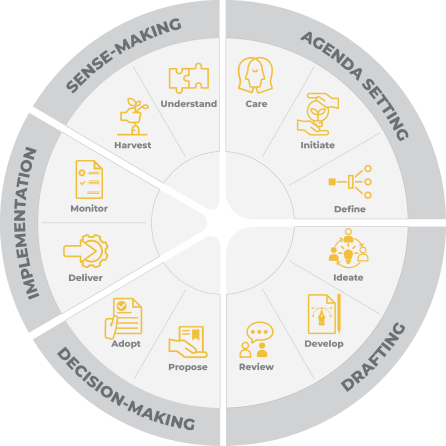2. Purpose: Process & Desired Outcome
The next step is to decide which design options the entire process will have. Usually a participatory process aims to influence a stage of public and collective decision-making. To achieve this, consider employing the ADDIS – Decision Thinking model as a guide to identify the desired outcomes. Determine at which phase of this process the participatory activity should take place, and envision the desired outcomes.

1. Agenda Setting: Identify and prioritize issues to address
- Care: to understand the people concerned by a decision area.
- Initiate: to launch a process to address a particular issue along with collaborators.
- Define: to identify and prioritize the specific issues, problems or opportunities, to be addressed.
2. Drafting: Potential solutions and strategies are developed
- Ideate: to explore, brainstorm, benchmark and evaluate potential solutions.
- Develop: to transform potential solutions into draft decisions.
- Consult: to share drafts for inputs and to then integrate feedback.
3. Decision-Making: The most viable path forward is chosen
- Propose: is to suggest a decision be taken.
- Adopt: to consider and approve a decision through an appropriate process.
4. Implementation: Decisions are put into practice and monitored
- Deliver: to communicate and execute the agreed decision.
Monitor: to track and assess implementation of a decision against desired results.
5. Sense-making: Reflect on outcomes which will then inform future decisions.
- Harvest: to gather insights from implementation and the overall process.
Understand: to make sense of observations, to inform and inspire future decisions.
We’ve organized dozens of cases from Participedia and Latinno according to the SDGs targeted to support you in finding references and inspirations.
